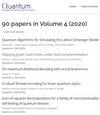Combinatorial NLTS From the Overlap Gap Property
IF 5.1
2区 物理与天体物理
Q1 PHYSICS, MULTIDISCIPLINARY
引用次数: 0
Abstract
In an important recent development, Anshu, Breuckmann, and Nirkhe [3] resolved positively the so-called No Low-Energy Trivial State (NLTS) conjecture by Freedman and Hastings. The conjecture postulated the existence of linear-size local Hamiltonians on n qubit systems for which no near-ground state can be prepared by a shallow (sublogarithmic depth) circuit. The construction in [3] is based on recently developed good quantum codes. Earlier results in this direction included the constructions of the so-called Combinatorial NLTS – a weaker version of NLTS – where a state is defined to have low energy if it violates at most a vanishing fraction of the Hamiltonian terms [2]. These constructions were also based on codes.In this paper we provide a "non-code" construction of a class of Hamiltonians satisfying the Combinatorial NLTS. The construction is inspired by one in [2], but our proof uses the complex solution space geometry of random K-SAT instead of properties of codes. Specifically, it is known that above a certain clause-to-variables density the set of satisfying assignments of random K-SAT exhibits an overlap gap property, which implies that it can be partitioned into exponentially many clusters each constituting at most an exponentially small fraction of the total set of satisfying solutions. We establish a certain robust version of this clustering property for the space of near-satisfying assignments and show that for our constructed Hamiltonians every combinatorial near-ground state induces a near-uniform distribution supported by this set. Standard arguments then are used to show that such distributions cannot be prepared by quantum circuits with depth o(log n). Since the clustering property is exhibited by many random structures, including proper coloring and maximum cut, we anticipate that our approach is extendable to these models as well.
从重叠间隙特性看组合无穷大系统
最近的一个重要进展是,安舒、布雷克曼和尼尔基[3]积极地解决了弗里德曼和黑斯廷斯提出的所谓无低能三维态(NLTS)猜想。该猜想假设在 n 个量子比特系统上存在线性大小的局部哈密顿,对于这些系统,浅层(亚对数深度)电路无法准备任何近地态。[3]中的构造基于最近开发的良好量子编码。这个方向的早期成果包括所谓的组合 NLTS(NLTS 的较弱版本)的构造,其中,如果一个态最多只违反了哈密顿项的消失部分,那么这个态就被定义为具有低能量[2]。这些构造也是基于代码的。在本文中,我们提供了一类满足组合 NLTS 的哈密尔顿的 "非代码 "构造。该构造受 [2] 中构造的启发,但我们的证明使用的是随机 K-SAT 的复杂解空间几何,而不是代码的属性。具体地说,众所周知,在超过一定的子句对变量密度时,随机 K-SAT 的满足赋值集会表现出重叠间隙特性,这意味着它可以被分割成指数级的多个簇,每个簇最多只构成满足解总集的指数级小部分。我们为近乎满足的赋值空间建立了这一聚类特性的某个稳健版本,并证明对于我们构建的哈密尔顿方程,每个组合近地状态都会诱导出由该集合支持的近乎均匀分布。然后,我们用标准论据证明,深度为 o(log n) 的量子电路无法准备这种分布。由于许多随机结构(包括适当着色和最大切割)都具有聚类特性,我们预计我们的方法也可以扩展到这些模型。
本文章由计算机程序翻译,如有差异,请以英文原文为准。
求助全文
约1分钟内获得全文
求助全文
来源期刊

Quantum
Physics and Astronomy-Physics and Astronomy (miscellaneous)
CiteScore
9.20
自引率
10.90%
发文量
241
审稿时长
16 weeks
期刊介绍:
Quantum is an open-access peer-reviewed journal for quantum science and related fields. Quantum is non-profit and community-run: an effort by researchers and for researchers to make science more open and publishing more transparent and efficient.
 求助内容:
求助内容: 应助结果提醒方式:
应助结果提醒方式:


